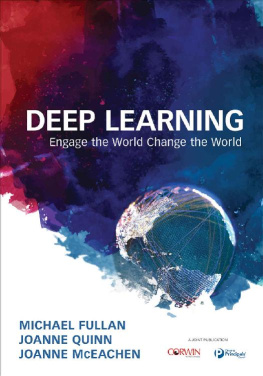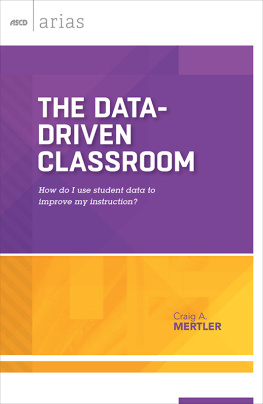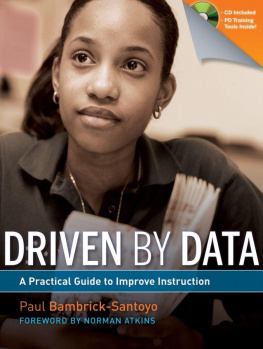Putting
FACES
on the Data
Dedicated to
Jim
who is always right beside me.
Lyn
Dedicated to
Harry, anonymous donor
Michael
LYN SHARRATT
MICHAEL FULLAN
Foreword by Sir Michael Barber
Putting
FACES
on the Data
WHAT GREAT LEADERS DO!


FOR INFORMATION:
Corwin
A SAGE Company
2455 Teller Road
Thousand Oaks, California 91320
(800) 233-9936
Fax: (800) 417-2466
www.corwin.com
SAGE Ltd.
1 Olivers Yard
55 City Road
London EC1Y 1SP
United Kingdom
SAGE India Pvt. Ltd.
B 1/I 1 Mohan Cooperative Industrial Area
Mathura Road, New Delhi 110 044
India
SAGE Asia-Pacific Pte. Ltd.
33 Pekin Street #02-01
Far East Square
Singapore 048763
Copyright 2012 by Corwin
All rights reserved. When forms and sample documents are included, their use is authorized only by educators, local school sites, and/or noncommercial or nonprofit entities that have purchased the book. Except for that usage, no part of this book may be reproduced or utilized in any form or by any means, electronic or mechanical, including photocopying, recording, or by any information storage and retrieval system, without permission in writing from the publisher.
Printed in the United States of America.
Library of Congress Cataloging-in-Publication Data
Sharratt, Lyn.
Putting FACES on the data: what great leaders do! / Lyn Sharratt, Michael Fullan; Foreword by Sir Michael Barber.
pages cm
A Joint Publication With Ontario Principals Council and Learning Forward.
Includes bibliographical references and index.
ISBN 978-1-4522-0258-7 (pbk.)
1. Educational tests and measurementsCase studies.
2. Effective teachingCase studies. I. Fullan, Michael. II. Title.
| LB3051.S44 2012 |
| 371.26dc23 | 2011053438 |
This book is printed on acid-free paper.
12 13 14 15 16 10 9 8 7 6 5 4 3 2 1
Acquisitions Editor: Arnis Burvikovs
Associate Editor: Desire A. Bartlett
Editorial Assistant: Kimberly Greenberg
Production Editor: Cassandra Margaret Seibel
Copy Editor: Amy Marks
Typesetter: C&M Digitals (P) Ltd.
Proofreader: Jennifer Gritt
Indexer: Sheila Bodell
Cover Designer: Michael Dubowe
Permissions Editor: Karen Ehrmann
CONTENTS
Sir Michael Barber
LIST OF FIGURES AND TABLES
FOREWORD
In this new book, Lyn Sharratt and Michael Fullan have performed a vital service for progressive education reformers around the world. They have shown not only that good data and good teaching go together but that success is possible only if in fact they do go together.
For many years, a powerful strand of the culture among educators has been skeptical about data, sometimes even rejecting it altogether. Great teaching, in this view, is about inspired individuals walking into a classroom and, through force of personality and knowledge of subject, engaging the students who happen to be in there. And of course we can all remember in our own lives teachers who did exactly this, so its a story were inclined to believe.
Moreover, it is argued, the data are at best limited and often out of date, and because so much of what makes great education great is hard to measure, the data force a reductionist perspective on schools and turn teachers into technicians.
Sharratt and Fullan demonstrate convincingly the flaws in this perspective. There will always be uniquely inspired teachers who rise above the mere mortals around them, but what the authors show here is that, if we want whole systems to succeed with every childwhich is indeed the challenge of the 21st centurythen we need collective capacity; and collective capacity involves teachers in each school and between schools engaging in serious conversation of what good teaching looks like and how it is achieved. For that conversation to be successful, evidence is required; and if the evidence is to go beyond the anecdotal, then good data are essential. Above all, Sharratt and Fullan demonstrate the vital two-way street between assessment and instructional improvement.
Of course, any data in any field have their limitations and learning from the data requires insight, analysis, and imagination. Data alone rarely make clear what needs to be done; rather they provide the basis for informed professionalism, the kind of professionalism that insists that, however good a teacher or school or system was yesterday, it should strive to be better tomorrow.
What makes the argument in Sharratt and Fullans book so powerful is their emphasis on putting FACES on the data, reminding us that the numbers represent real children and young people striving to make the most of themselves as they prepare for an uncertain future. This perspective applies not just at the level of the classroom and the school, but also at the level of the district and the state or province. In my own experience of bringing the data to bear on domestic policy priorities at No.10 Downing Street, I tried always to remember that, however aggregated the data, they represent real livesevery 1 percent increase in the reliability of trains represented a million extra journeys that started and finished on time; every 1 percent increase in children reaching the standard in English or mathematics at age 11 represented 7,000 more children ready to succeed in secondary education; reductions in drug abuse represented so many family tragedies avoided; and so on.
Sharratt and Fullan bring this perspective to bear excellently not least because, in addition to writing about education, both have direct experience in education reform at different levels in the Ontario system, Sharratt in a senior position in the York Region District School Board and Fullan as adviser on education to Ontario premier Dalton McGuinty. The reform they have been part of is exemplary in its consistency and success in building principals and teachers capacity. Above all, it has delivered results at every level. As this book shows so clearly, using the data at every level, from classroom to province or state, is a vital ingredient of successful whole system reform.
I recommend this book for every educator, wherever they are in the world, who wants to master using data to drive up performance and who believes that every child, every FACE, needs to count and be counted.
Sir Michael Barber
Chief Education Advisor, Pearson
PREFACE
Statistics are a wonderful servant and an appalling master.
Hopper & Hopper, 2009
Technology and accountability have generated a data dump on teachers. There is no longer a shortage of information; its just the oppositea glut. We tackled many of the problems that arise from too much information in our previous publication, Realization (Sharratt & Fullan, 2009). Using the 14 parameters of district-wide success that we developed in our work in the York Region District School Board, we showed how schools and the district as a whole were able to realize improvements on a wide scale. But we did not really delve into the role of data in a deep, human way.
In FACES, we go deeper in our quest to balance and integrate two aspects of school improvement that look like they cant be brought together: on the one hand is the question of how you personalize data for all students so that each is treated as a real person and helped to learn according his or her own individual needs; on the other hand is the question of how you do this for 100,000 students at a time without losing the human touch. FACES does just this, honoring and helping the individual, and improving the system.
Next page













